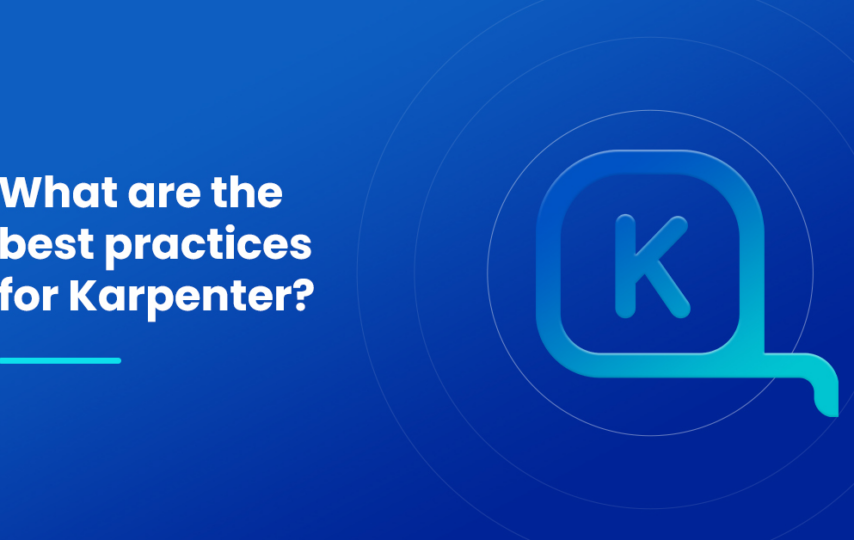Karpenter, an open-source Kubernetes-native autoscaling solution, has gained significant popularity due to its ability to efficiently manage and optimize resource allocation in Kubernetes clusters. To harness the full potential of Karpenter, it is essential to understand and implement the best practices. In this blog, we will explore the key strategies and guidelines to follow when using Karpenter for autoscaling, ensuring the scalability, performance, and cost-efficiency of your Kubernetes workloads.
- Understand Your Workload
Before implementing Karpenter, it is crucial to analyze and understand your workload patterns. Consider the resource demands, usage patterns, and peak times of your applications. This information will help you define appropriate scaling policies in Karpenter. By accurately predicting your workload requirements, you can ensure that Karpenter scales your resources optimally, avoiding unnecessary under- or over-provisioning.
- Define Resource Requests and Limits
Setting resource requests and limits for your Kubernetes pods is vital for effective autoscaling with Karpenter. Properly defining these values helps Karpenter make informed decisions about when and how to scale your applications. Resource requests specify the minimum resources required for a pod to function correctly, while resource limits define the maximum amount of resources a pod can consume. By setting these values accurately, Karpenter can effectively allocate resources and ensure optimal performance.
- Configure Karpenter Policies
Karpenter offers various policies that allow you to fine-tune the autoscaling behavior based on your specific needs. These policies include target average utilization, target value, and binpacking. The target average utilization policy ensures that resources are scaled based on their utilization, maintaining a desired average utilization across the cluster. The target value policy enables you to set specific thresholds for scaling resources based on custom metrics. The binpacking policy optimizes resource allocation by grouping similar workloads together, maximizing resource utilization.
- Monitor and Analyze Metrics
Continuous monitoring and analysis of metrics are essential for optimizing Karpenter’s performance. Monitor key metrics such as CPU and memory utilization, request queue length, and response times to identify potential bottlenecks or areas of improvement. Utilize Kubernetes monitoring tools or external monitoring solutions to collect and analyze these metrics. Regularly review the metrics to identify any deviations or anomalies and fine-tune your Karpenter configurations accordingly.
- Regularly Update Karpenter
Keeping your Karpenter installation up to date is crucial to benefit from the latest features, bug fixes, and performance enhancements. Stay informed about new releases and updates by following the official Karpenter documentation and community channels. Test new versions in a non-production environment before rolling them out to your production clusters. Regularly updating Karpenter ensures that you have access to the most stable and optimized version, enhancing the overall performance and reliability of your autoscaling capabilities.
- Consider Horizontal and Vertical Scaling
When using Karpenter, it’s important to consider both horizontal and vertical scaling options. Horizontal scaling involves adding more instances of your application to distribute the workload, while vertical scaling involves increasing the resources allocated to a single instance. Depending on your application’s requirements, you may need to adjust your scaling strategy. Karpenter allows you to define scaling policies based on various metrics, such as CPU utilization or custom metrics. By carefully analyzing your application’s performance and resource usage, you can determine whether horizontal or vertical scaling is more appropriate for your specific use case and configure Karpenter accordingly.
- Utilize Node Affinity and Anti-Affinity
Karpenter provides node affinity and anti-affinity features that allow you to control pod placement within the cluster. Node affinity ensures that pods are scheduled on specific nodes based on labels, enabling you to allocate resources strategically. Conversely, anti-affinity ensures that pods are not scheduled on nodes that already have similar pods, promoting better resource distribution. By utilizing these features, you can optimize resource utilization, improve application performance, and minimize the chances of resource contention within the cluster.
Conclusion
Implementing best practices for Karpenter is essential to ensure efficient and optimized autoscaling in your Kubernetes clusters. By understanding your workload, setting resource requests and limits, configuring Karpenter policies, monitoring metrics, and regularly updating Karpenter, you can maximize the scalability, performance, and cost-efficiency of your applications. As Karpenter continues to evolve and improve, staying up to date with the latest best practices will enable you to harness its full potential and deliver robust, scalable solutions in your Kubernetes environment.







